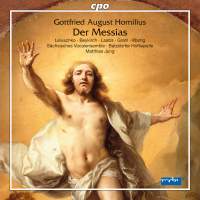Texte paru dans: / Appeared in: |
|
| "Outstanding in every respect, and strongly recommended." |
Outil de traduction ~ (Très approximatif) |
|
Reviewer: Jerry
Dubins There are enough entries under Homilius in the Fanfare Archive that it can’t be said he’s unknown to the magazine’s readers or that his music is completely unfamiliar to collectors, especially to those with a special interest in post-Bach Lutheran church music. I, on the other hand, having never heard a single note of Gottfried August Homilius’s music before this, was curious about this release for another reason. I wondered if a composer who studied organ under Bach, served as organist at the Frauenkirche in Dresden from 1742 to 1755, and from then until his death in 1785 as cantor and music director at the Kreuzkirche in Dresden, could possibly have had any knowledge of Handel’s iconic Messiah and, if he did, what influence it might have had on his own Der Messias. The answer is a resounding “no” on both counts; Homilius had no knowledge of Handel’s oratorio and therefore could not have been influenced by it. Gerhard Poppe’s album note tells us that Handel’s Messiah wasn’t heard in Germany before 1780, and that Homilius’s Der Messias dates from sometime between 1775 and 1777. Being exclusively church-bound for his entire career, I don’t know that Homilius composed anything other than music for the Lutheran church. His output includes over 10 Passion settings, Christmas and Easter oratorios, 150 cantatas, 60 motets, and volumes of organ preludes, chorales, and other choral works. That is reflected in the several reviews one finds under Homilius in past issues of the magazine. In terms of musical style, Homilius’s Der Messias seems to be of two minds. The chorales and recitatives, both secco and accompagnato, are very close to J. S. Bach—in a number of instances, almost indistinguishable, really—but when it comes to the solo arias and choruses, the music is much closer to the pre-Classical style of C. P. E. Bach, and it can be strikingly dramatic, as in “Wie wirds euch, Frechen, gehen” (What will happen to you, impudent people, when his wrath is kindled). On the whole, however, as note author Poppe writes, “Despite its title, Der Messias is not a Messiah oratorio continuing from Handel’s work … but a passion oratorio of the type employed in many places in Protestant Germany during the second half of the 18th century.” This is borne out by the lengthy stretches of recitative, which function as narration that advances the action, while the arias provide commentary and reflection on the developing drama, very much in the manner of Bach’s St. Matthew Passion and St. John Passion. An interesting difference, though, is that where Bach employs a single narrator throughout in the role of Evangelist, Homilius alternates the storytelling recitatives between his solo singers, generally following them with a solo aria or duet for the same vocalist(s). In this regard, Der Messias more closely resembles one of Bach’s cantatas than it does one of his Passions. Frankly, I wasn’t expecting to find Homilius’s Der Messias all that appealing, but if it is representative of his work in general, I think I can say that we’re dealing here with a major 18th-century German church composer whose music definitely warrants greater exposure. Arias are tuneful, appealing, touching, and memorable; choruses rhythmically alive and rousing; and chorales sincerely devotional and moving. There’s a good chance that you’ve never heard of most of the solo singers here, the Saxon Vocal Ensemble, or the Dresden-based Batzdorfer Hofkappele, though I do note a few Fanfare Archive entries for the chorus, orchestra, and conductor Matthias Jung. No matter; there’s not a weak voice among the soloists, the chorus sings gloriously, and the period instrument ensemble is terrific. I would also note that the performing forces are of respectable size: 23 choristers, four each of first and second violins, three violas, two cellos, double bass, flutes, oboes, bassoons, and horns in pairs, timpani, organ, and harpsichord. The recording was made in concert on June 5, 2014, at St Anne’s Church in Dresden on the occasion of the 300th anniversary of the composer’s birth.
Outstanding in every respect, and strongly recommended. | |
|
|
|
|
Cliquez l'un ou l'autre
bouton pour découvrir bien d'autres critiques de CD |
|




